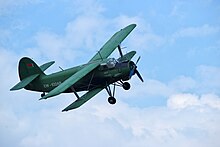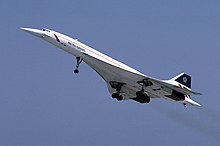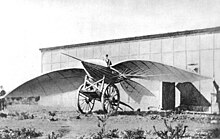Propulsion
Propeller
An aircraft propeller, or airscrew, converts rotary motion from an engine or other power source, into a swirling slipstream which pushes the propeller forwards or backwards. It comprises a rotating power-driven hub, to which are attached several radial airfoil-section blades such that the whole assembly rotates about a longitudinal axis.[32] Three types of aviation engines used to power propellors include reciprocating engines (or piston engines), gas turbine engines, and electric motors. The amount of thrust a propeller creates is determined by its disk area—the area in which the blades rotate. If the area is too small, efficiency is poor, and if the area is large, the propeller must rotate at a very low speed to avoid going supersonic and creating a lot of noise, and not much thrust. Because of this limitation, propellers are favored for planes that travel at below Mach 0.6, while jets are a better choice above that speed.[33] Propeller engines may be quieter than jet engines (though not always) and may cost less to purchase or maintain and so remain common on light general aviation aircraft such as the Cessna 172. Larger modern propeller planes, such as the Dash 8, use a jet engine to turn the propeller, primarily because an equivalent piston engine in power output would be much larger and more complex.
Reciprocating engine
Reciprocating engines in aircraft have three main variants, radial, in-line and flat or horizontally opposed engine. The radial engine is a reciprocating type internal combustion engine configuration in which the cylinders "radiate" outward from a central crankcase like the spokes of a wheel and was commonly used for aircraft engines before gas turbine engines became predominant. An inline engine is a reciprocating engine with banks of cylinders, one behind another, rather than rows of cylinders, with each bank having any number of cylinders, but rarely more than six, and may be water-cooled. A flat engine is an internal combustion engine with horizontally-opposed cylinders.
Gas turbine
A turboprop gas turbine engine consists of an intake, compressor, combustor, turbine, and a propelling nozzle, which provide power from a shaft through a reduction gearing to the propeller. The propelling nozzle provides a relatively small proportion of the thrust generated by a turboprop.
Electric motor
An electric aircraft runs on electric motors rather than internal combustion engines, with electricity coming from fuel cells, solar cells, ultracapacitors, power beaming,[34] or batteries. Currently, flying electric aircraft are mostly experimental prototypes, including manned and unmanned aerial vehicles, but there are some production models on the market already.[35]
Jet
Jet aircraft are propelled by jet engines, which are used because the aerodynamic limitations of propellers do not apply to jet propulsion. These engines are much more powerful than a reciprocating engine for a given size or weight and are comparatively quiet and work well at higher altitude. Variants of the jet engine include the ramjet and the scramjet, which rely on high airspeed and intake geometry to compress the combustion air, prior to the introduction and ignition of fuel. Rocket motors provide thrust by burning a fuel with an oxidizer and expelling gas through a nozzle.
Turbofan
Most modern jet planes use turbofan jet engines, which balance the advantages of a propeller while retaining the exhaust speed and power of a jet. This is essentially a ducted propeller attached to a jet engine, much like a turboprop, but with a smaller diameter. When installed on an airliner, it is efficient so long as it remains below the speed of sound (or subsonic). Jet fighters and other supersonic aircraft that do not spend a great deal of time supersonic also often use turbofans, but to function, air intake ducting is needed to slow the air down so that when it arrives at the front of the turbofan, it is subsonic. When passing through the engine, it is then re-accelerated back to supersonic speeds. To further boost the power output, fuel is dumped into the exhaust stream, where it ignites. This is called an afterburner and has been used on both pure jet aircraft and turbojet aircraft although it is only normally used on combat aircraft due to the amount of fuel consumed, and even then may only be used for short periods of time. Supersonic airliners (e.g. Concorde) are no longer in use largely because flight at supersonic speed creates a sonic boom, which is prohibited in most heavily populated areas, and because of the much higher consumption of fuel supersonic flight requires.
Jet aircraft possess high cruising speeds (700–900 km/h or 430–560 mph) and high speeds for takeoff and landing (150–250 km/h or 93–155 mph). Due to the speed needed for takeoff and landing, jet aircraft use flaps and leading edge devices to control the lift and speed. Many jet aircraft also use thrust reversers to slow down the aircraft upon landing.
Ramjet
A ramjet is a form of jet engine that contains no major moving parts and can be particularly useful in applications requiring a small and simple engine for high-speed use, such as with missiles. Ramjets require forward motion before they can generate thrust and so are often used in conjunction with other forms of propulsion, or with an external means of achieving sufficient speed. The Lockheed D-21 was a Mach 3+ ramjet-powered reconnaissance drone that was launched from a parent aircraft. A ramjet uses the vehicle's forward motion to force air through the engine without resorting to turbines or vanes. Fuel is added and ignited, which heats and expands the air to provide thrust.[36]
Scramjet
A scramjet is a supersonic ramjet and aside from differences with dealing with internal supersonic airflow works like a conventional ramjet. This type of engine requires a very high initial speed in order to work. The NASA X-43, an experimental unmanned scramjet, set a world speed record in 2004 for a jet-powered aircraft with a speed of Mach 9.7, nearly 12,100 kilometers per hour (7,500 mph).[37]
Rocket
In World War II, the Germans deployed the Me 163 Komet rocket-powered aircraft. The first plane to break the sound barrier in level flight was a rocket plane – the Bell X-1. The later North American X-15 broke many speed and altitude records and laid much of the groundwork for later aircraft and spacecraft design. Rocket aircraft are not in common usage today, although rocket-assisted take offs are used for some military aircraft. Recent rocket aircraft include the SpaceShipOne and the XCOR EZ-Rocket.
There are many rocket-powered aircraft/spacecraft planes, the spaceplanes, that are designed to fly outside Earth's atmosphere.










